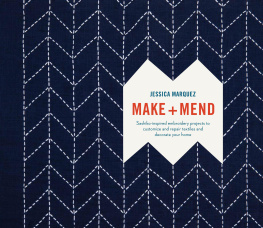Ministry of Information - Make Do and Mend
Here you can read online Ministry of Information - Make Do and Mend full text of the book (entire story) in english for free. Download pdf and epub, get meaning, cover and reviews about this ebook. year: 2016, publisher: G2 Rights Ltd, genre: Home and family. Description of the work, (preface) as well as reviews are available. Best literature library LitArk.com created for fans of good reading and offers a wide selection of genres:
Romance novel
Science fiction
Adventure
Detective
Science
History
Home and family
Prose
Art
Politics
Computer
Non-fiction
Religion
Business
Children
Humor
Choose a favorite category and find really read worthwhile books. Enjoy immersion in the world of imagination, feel the emotions of the characters or learn something new for yourself, make an fascinating discovery.
- Book:Make Do and Mend
- Author:
- Publisher:G2 Rights Ltd
- Genre:
- Year:2016
- Rating:3 / 5
- Favourites:Add to favourites
- Your mark:
- 60
- 1
- 2
- 3
- 4
- 5
Make Do and Mend: summary, description and annotation
We offer to read an annotation, description, summary or preface (depends on what the author of the book "Make Do and Mend" wrote himself). If you haven't found the necessary information about the book — write in the comments, we will try to find it.
Make Do and Mend — read online for free the complete book (whole text) full work
Below is the text of the book, divided by pages. System saving the place of the last page read, allows you to conveniently read the book "Make Do and Mend" online for free, without having to search again every time where you left off. Put a bookmark, and you can go to the page where you finished reading at any time.
Font size:
Interval:
Bookmark:
IMPERIAL WAR MUSEUMS

G2 Entertainment Limited 2016
www.G2ent.co.uk
First published by the Ministry of Information in 1943
First published in 2007 in this format by
IWM, Lambeth Road, London SE1 6HZ
This edition printed 2016
iwm.org.uk
Text as reproduced in this volume Crown Copyright All rights reserved. No part of this publication may be reproduced, stored in a retrieval system or transmitted, in any form or by any means, electronic, mechanical, photocopying, recording or otherwise without the prior permission of the copyright holder and publisher.
eISBN 978-1-782816-70-6
With 29 line illustrations
*
Prepared for the Board of Trade by the Ministry of Information
First, I would like to thank you all for the way in which you have accepted clothes rationing. You know how it has saved much-needed shipping space, man-power and materials, and so assisted our war effort.
The Board of Trade Make Do and Mend campaign is intended to help you to get the last possible ounce of wear out of all your clothes and household things. This booklet is part of that campaign, and deals chiefly with clothes and household linen.
No doubt there are as many ways of patching or darning as there are of cooking potatoes. Even if we ran to several large volumes, we could not say all there is to say about storing, cleaning, pressing, destroying moths, mending and renovating clothes and household linen.
But the hints here will, I hope, prove useful. They have all been tested and approved by the Board of Trade Make Do and Mend Advisory Panel, a body of practical people, mostly women, for whose help in preparing this booklet I am most grateful.


Clothes have simply got to last longer than they used to, but only the careful woman can make them last well. If you want to feel happy in your clothes as long as they last, start looking after them properly from the very beginning.
Here are some hints to help you.
1. Mend clothes before washing them or sending them to the laundry, or the hole or tear may become unmanageable. Thin places especially must be dealt with, or they may turn into holes.
2. Always change into old things, if you can, in the house, and give the clothes you have just taken off an airing before putting them away.
3. Dont throw your things down in a heap when you take them off; when they are still warm the material will crease. Brush them with a short-haired brush (a long whisk picks up the fibres) and shake them well. Then hang them on hangers, making sure that the hangers are wide enough. A hanger that is too narrow will ruin the shape of the shoulder and may even make a hole. For skirts, cut a notch each end of the hanger to stop the loops slipping off.
Do up all fastenings before hanging clothes. This helps them to keep their shape. And see that the shoulders are even on the hanger and not falling off one side.
4. See that the wardrobe door shuts tightly, to keep out dust and moth.
5. Remove all stains at once, as they usually come out fairly easily before they are set.
For grease use a hot iron on a piece of clean white blotting paper placed over the stain.
For all other stains try plain tepid water first, and then soap and water. If you still cant get the stain out, send the article to the cleaners, and put a note on it saying what the stain is.
6. Keep a look out for loose buttons and other fastenings, frayed buttonholes and split seams, and mend them at once.
7. It is best to wear clothes in turn, as a rest does them good. Shoes, too, are better for not being worn day after day.
8. Never let clothes get really dirty. Dirt injures the fabric, so clean or wash clothes when slightly soiled.
9. Use dress shields to protect clothes from perspiration, but dont leave shields in when putting clothes away for any length of time.
1. Put away clothes in the condition in which you will want to wear them when you take them out again.
2. Make quite sure they are absolutely clean; dirt attracts clothes moths.
3. Give clothes a good brushing and airing in the open air in the sun if possible taking care to turn out pockets and look behind collars and seams for dust and fluff and moth eggs.
4. Never store clothes in a damp place, or they may get mildewed.
5. It is well worth while to tack down all pleats, pocket openings and revers, and sew together buttonholes if you can spare the time.
6. Cover all shoulders on hangers with a collar of newspaper.
7. When folding clothes, put bunched-up newspaper between the folds to prevent creases.
8. Finally, dont forget all about the things you have put away, but give them a thorough airing, and examine for moth as often as you can.
From September to spring is the time when your clothes are in most danger from moths. It is the grub which eats the material, and although the moth lays its eggs mainly in wool, it sometimes lays them in other types of material. So keep a look out for moth eggs in all your clothes. If you carry out the following suggestions you can be reasonably sure of keeping the clothes moth away.
1. Moths like warm, dark cupboards anywhere in fact, where they are not disturbed. At least once a month, more often if possible, beat, brush and shake your clothes well, particularly woollens, and air them in the sunlight out of doors. Sun and air kill the grub.
2. Turn out pockets and look behind collars and in turnings for any signs of eggs or grubs. The eggs are each about the size of a pin-head. The grubs are whitish-yellow, about a quarter of an inch long when fully grown.
If there are any signs of moth, brush vigorously first, then iron with a hot iron over a damp cloth. Even if you cant see the eggs it is a good plan to iron in this way. This is a particularly effective method for carpets.
3. When putting away clothes make quite sure there are no signs of moth.
4. Scrub out cupboards and drawers, being sure to get into the cracks and corners, and when you have put your things away seal up the drawer or cupboard as tightly as possible.
Boots and Shoes. Since boots and shoes are so important you cannot take too much care of them. Have them repaired as soon as they show signs of wear; in particular, never walk down the heels. You can get half-soles and toe-pieces put on, which will save you money and save the country leather. Take the advice of your repairer. Dont ask for the heel to be raised or lowered or extra pieces to be put on the top. This throws the shoe out of balance, and corns and callouses will probably result.
Regular cleaning and polishing prolongs the life of shoes by keeping the leather supple. Shoes should be put on trees or stuffed with paper as soon as you take them off because the leather is warm and supple then and can be coaxed into shape.
Never dry wet shoes near heat. A leather sole may be ruined in this way. Even if it looks normal, the fibres inside will have so deteriorated that it feels hard and brittle, and is scarcely recognisable as leather. Dont put trees in wet shoes or they may stretch; stuff them tightly with paper, then leave them in a cool, dark place. Of course, sitting in front of the fire with them on isnt any better than putting them on the fender to dry!
Font size:
Interval:
Bookmark:
Similar books «Make Do and Mend»
Look at similar books to Make Do and Mend. We have selected literature similar in name and meaning in the hope of providing readers with more options to find new, interesting, not yet read works.
Discussion, reviews of the book Make Do and Mend and just readers' own opinions. Leave your comments, write what you think about the work, its meaning or the main characters. Specify what exactly you liked and what you didn't like, and why you think so.

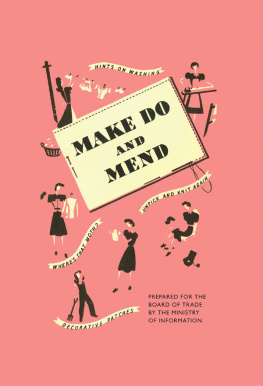


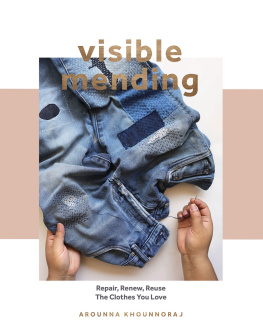
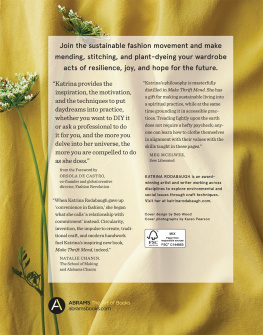
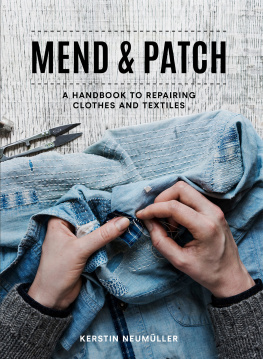
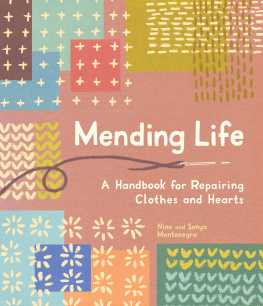
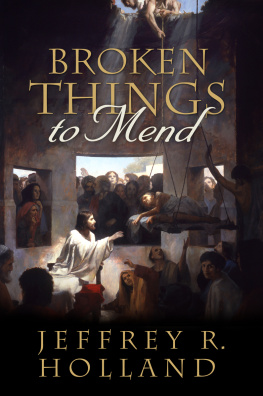
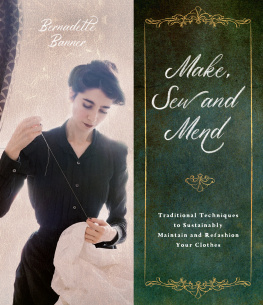
![Noriko Misumi [ミスミノリコ] - Mending with Love: Creative Repairs for Your Favorite Things](/uploads/posts/book/306555/thumbs/noriko-misumi-mending-with.jpg)


